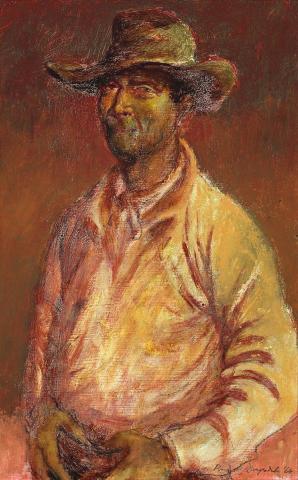THE HEAD STOCKMAN, 1964
RUSSELL DRYSDALE
oil on composition board
30.5 x 20.0 cm
signed and dated lower right: Russell Drysdale '64
Rt Hon William Sidney De L'Isle, 1st Viscount De L'Isle, VC, KG, GCMG,
GCVO, PC (15th Governor General of Australia), Canberra and United Kingdom
Thence by descent
Private collection, United Kingdom
When The Head Stockman 1964 was lent by the Rt. Hon. Viscount De L'Isle to Russell Drysdale's exhibition at London's Leicester Galleries in 1965 it was in extraordinarily good company. An iconic image, it not only joined other master works by Drysdale, but was also in a very distinguished company of lenders and buyers. They were among the most prominent collectors in Britain and Australia including Evelyn de Rothschild, Lord Glendevon, Harold Mertz from the USA, Peter Sculthorpe, Mr and Mrs Geoffrey Collings, and Mr and Mrs Philip Simpson. The Art Gallery of Western Australia lent The Gatekeeper's Wife 1965. It was a breath-taking show, difficult to select one masterpiece from another. This was confirmed years later when several were chosen for inclusion in the Drysdale retrospective exhibition presented by the National Gallery of Victoria in 1997, then toured to the State Galleries of New South Wales, Queensland, Tasmania and to Darwin.
Drysdale's images of the Australian outback and its peoples have become part of the way in which we see and understand our country. As Sidney Nolan said, 'Drysdale is the most Australian of us all.'1 Red skies of surreal vastness and Venetian splendour, infinite horizons, the resilience of peoples and their integration with the landscape are the distinguishing characteristics of his art. The 1965 Leicester Galleries exhibition presented such classic examples as Red Landscape 1965 and The Ruins, Lake Callabonna 1965. Significantly, half the paintings were portraits of Outback characters and other individuals, of the singular Brandy John 1965, or figures stoic in stance and character as in Tom Finch 1964 and our painting, The Head Stockman. These are set against richly coloured, painterly backgrounds in which no details detract from the image. They are marked by time, isolated but unbowed images of the Australian character - laconic of mien, of rugged individualism and egalitarianism. The immediacy of Drysdale's characters comes from the artist's own sense of mateship and the genesis of his paintings in lively sketches made on the spot. Much of the magic of his art comes from that warm personality which was Drysdale. Alan Ross, editor of the London Magazine described him as 'an artist with a tough, masculine temperament and seductive painterly skills...'2 The combination is still unrivalled in Australian art, giving us a unique collection of portraits of characters of the Outback, indigenous and of more recent arrival. Direct of gaze and nonchalant of pose with thumbs tucked idly into his belt, The Head Stockman, presents a quintessential image of one of them.
1. Nolan, S., quoted in Ross, A., 'Preface', Russell Drysdale, The Leicester Galleries, London, 1965, n.p.
2. ibid.
DAVID THOMAS
